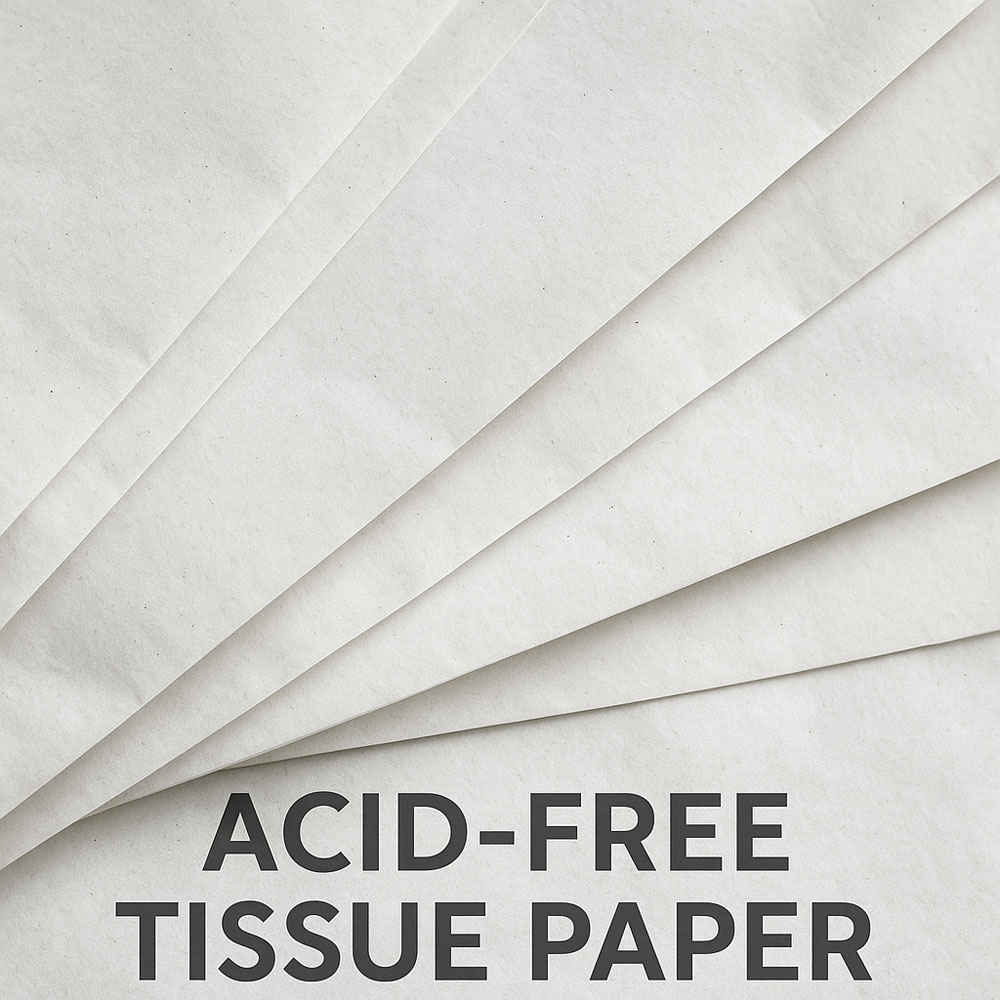When it comes to packaging delicate items like clothing, artwork, collectibles, or archival documents, not all tissue papers are the same. One type stands out for its protective and long-lasting qualities — acid-free tissue paper. It has become an essential material for museums, fashion retailers, e-commerce brands, and even eco-conscious consumers who care about both preservation and sustainability.

What Is Acid-Free Tissue Paper?
Acid-free tissue paper is a specially processed paper made without the acidic chemicals that cause ordinary paper to yellow, weaken, or damage the items it comes into contact with. In scientific terms, it has a neutral or slightly alkaline pH level, typically between 7 and 8.5.
During normal paper production, acids (like lignin or sulfur compounds) remain in the fibers, making them degrade over time. Acid-free tissue paper is manufactured by removing these substances and sometimes adding calcium carbonate to neutralize any remaining acidity.
Properties of Acid-Free Tissue Paper
The defining characteristics of acid-free tissue paper make it ideal for long-term use and sensitive packaging. Here are its main properties:
pH Neutrality (Non-Acidic Nature)
Acid-free paper maintains a neutral pH that prevents the breakdown of fibers, dyes, and surfaces of stored items.
Lignin-Free Composition
Lignin, a natural component of wood pulp, produces acid as it ages. By removing lignin, the paper stays stable and does not become brittle or discolored.
Buffered and Unbuffered Options
Buffered acid-free tissue paper contains calcium carbonate to protect against external acidity, ideal for paper, cotton, or linen items. On the other hand, unbuffered acid-free tissue paper is preferred for storing protein-based materials like silk, wool, or leather, which can react negatively with alkaline buffers.
Soft and Lightweight Texture
It’s thin, smooth, and non-abrasive — perfect for wrapping fragile or polished surfaces.
Durable and Non-Yellowing
Even after years of storage, acid-free tissue paper retains its white or off-white appearance and does not stain or crumble.
Uses of Acid-Free Tissue Paper
The versatility of acid-free tissue paper makes it valuable in many industries. Below are the most common applications:
1. Archival and Museum Storage
Museums and libraries use acid-free tissue paper to protect priceless artifacts, photographs, and manuscripts. It prevents chemical reactions that can fade inks or corrode materials over time.
2. Fashion and Textile Packaging
Retailers and designers use it to wrap luxury clothing, wedding dresses, handbags, and shoes. It keeps fabrics fresh and prevents color transfer or wrinkles during storage.
3. Artwork and Photography
Artists and photographers rely on acid-free tissue paper to separate paintings, prints, and negatives. It safeguards them from smudges, scratches, and acid migration.
4. Jewelry and Collectibles
Acid-free tissue paper provides a non-reactive barrier that prevents metal tarnish and keeps collectibles, coins, or ornaments looking new.
5. Gift Wrapping and Branding
Eco-friendly brands use acid-free tissue paper for premium packaging. It not only looks elegant but also aligns with sustainable marketing.
6. Electronics and Delicate Items
For certain electronics or optical instruments, acid-free paper offers static-free, residue-free protection during shipping or storage.
Benefits of Acid-Free Tissue Paper
Choosing acid-free tissue paper offers both functional and environmental advantages:
1. Long-Term Preservation: It extends the life of stored items by preventing yellowing, fading, and chemical deterioration.
2. Non-Reactive and Safe: The neutral pH ensures no damage to sensitive materials like fabrics, metals, or photographic films.
3. Professional Presentation: Its clean, elegant appearance enhances product unboxing experiences — ideal for high-end retail and e-commerce.
4. Eco-Friendly and Sustainable: Many acid-free tissue papers are made from recycled or responsibly sourced pulp, aligning with eco-conscious packaging trends.
5. Versatile and Cost-Effective: It’s suitable for both small-scale craft packaging and large-volume industrial storage — offering great value for long-term protection.
Acid-Free Paper vs Regular Paper
Let’s break down the key differences between acid-free tissue paper and regular tissue paper:
| Feature | Acid-Free Tissue Paper | Regular Tissue Paper |
| pH Level | Neutral or slightly alkaline (7–8.5) | Acidic (below 7) |
| Lignin Content | Lignin-free | Contains lignin |
| Longevity | Long-lasting; does not yellow | Yellows, weakens over time |
| Material Safety | Safe for textiles, art, metals | May cause stains or deterioration |
| Environmental Impact | Often recyclable and eco-friendly | May not be environmentally safe |
| Cost | Slightly higher | Cheaper but less durable |
In short, acid-free paper is the smarter choice when quality, durability, and product integrity matter — especially for long-term storage or brand presentation.
How to Identify Acid-Free Tissue Paper
Before purchasing, it’s crucial to verify that your tissue paper is truly acid-free. Here’s how you can identify it:
Check the Label or Product Description: Reliable manufacturers will clearly state “acid-free” or “archival quality” on the packaging or data sheet.
pH Testing: Use pH indicator pens (available at art or archival supply stores). Draw a small mark on the paper — if it turns blue or purple, the paper is neutral/alkaline; if yellow, it’s acidic.
Look for Lignin-Free and Buffered Indications: “Lignin-free” or “buffered with calcium carbonate” are good signs of high-quality acid-free paper.
Observe Longevity and Color Stability: Acid-free tissue paper maintains its original color and softness over time, unlike regular tissue paper that becomes brittle or discolored.
Buy from Trusted Suppliers: Always source from reputable paper manufacturers or archival suppliers who specialize in conservation-grade materials.
Conclusion
Acid-free tissue paper is more than just a wrapping material — it’s a protective shield that preserves the quality, beauty, and longevity of your valuable items. Whether you’re an artist, museum curator, fashion retailer, or eco-friendly brand, switching to acid-free tissue paper is an investment in both quality and sustainability. It safeguards against acid damage, enhances presentation, and supports environmentally responsible practices — making it a smart, modern solution for packaging and preservation.